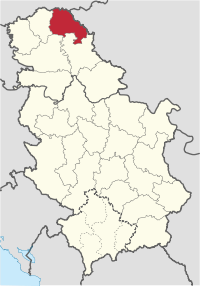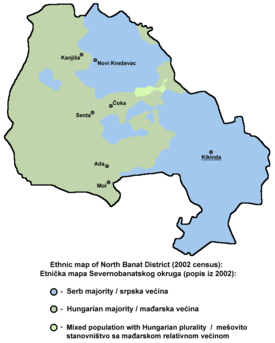- North Banat District
-
Severnobanatski okrug
Севернобанатски округ
Észak-bánsági körzet— District of Serbia — Location of North Banat District in Serbia Country  Serbia
SerbiaCapital Kikinda Government – Commissioner n/a Area – Total 2,329 km2 (899.2 sq mi) Population (2002 census) – Total 165,881 – Density 71.2/km2 (184.4/sq mi) Municipalities 6 Settlements 50 - Cities and towns 7 - Villages 43 North Banat District (Serbian: Севернобанатски округ, Severnobanatski okrug, Hungarian: Észak-bánsági körzet, Croatian: Sjevernobanatski okrug, Slovak: Severobanátsky okres, Romanian: Districtul Banatul de Nord, Rusyn: Сивернобанатски окрух) is a northern district of Serbia. It lies in the regions of Banat and Bačka, in the autonomous province of Vojvodina. As of the 2002 census, the district has a population of 165,881. The seat of the district is Kikinda.
Contents
Municipalities
The North Banat District comprises 6 municipalities and 50 local communities. The municipalities are:
- Kanjiža (Hungarian: Magyarkanizsa)
- Senta (Hungarian: Zenta)
- Ada (Hungarian: Ada)
- Čoka (Hungarian: Csóka)
- Novi Kneževac
- Kikinda
Note: for municipalities with Hungarian ethnic majority, the names are also given in Hungarian.
An interesting fact is that the first three municipalities enlisted (Kanjiža, Senta and Ada) are geographically, in fact, in the Bačka region since the natural border between Banat and Bačka is the river Tisa.
Demographics
The district is ethnically mixed. Its population is composed of (Census 2002):
- Hungarians = 78,551 (47.35%)
- Serbs = 72,242 (43.55%)
- Roma = 3,944 (2.37%)
- Yugoslavs = 3,018 (1.81%)
- Others
Languages spoken in the District (Census 2002):
Municipalities with Serb ethnic majority are Kikinda (76.43%) and Novi Kneževac (59.53%), while municipalities with Hungarian ethnic majority are: Ada (76.64%), Čoka (51.56%), Kanjiža (86.52%), and Senta (80.51%).
As for local communities, 30 have Hungarian majority, 19 have Serb majority, and 1 is ethnically mixed, with Hungarian relative majority.
Culture
The first modern Serb printing-house was founded in Kikinda in 1878, to be followed a year later by the opening of the first library.
This city is also reputable for its painters, including Teodor Ilić Češljar, Nikola Aleksić, Đura Pecić, and Đura Jakšić, a painter and author.
Kikinda was the scene of the region's first theatrical performance, given in German, in 1796.
Economy
Kikinda is the center of the Serbian clay building materials production, as a seat of the IGM DD "Toza Marković" company, which is the oldest clay producer in Europe. The "Kikinda" foundry is the major Serbian producer and exporter of grinders. Also the "25 maj" factory of agricultural machines and equipment, and the "Electron" are the factories running production for both the local and foreign markets.
See also
Cities, towns and villages in the North Banat District Kikinda Banatska Topola • Banatsko Veliko Selo • Bašaid • Iđoš • Mokrin • Nakovo • Novi Kozarci • Rusko Selo • SajanAda Kanjiža Adorjan • Velebit • Doline • Zimonić • Male Pijace • Mali Pesak • Martonoš • Novo Selo • Orom • Totovo Selo • Trešnjevac • HorgošNovi Kneževac Senta Čoka Districts of Serbia Vojvodina Central Serbia Kosovo and Metohija1 1 Sovereignty disputed with the Republic of Kosovo. These are the districts recognized by the Republic of Serbia. For the districts recognized by the Republic of Kosovo, see Districts of Kosovo.Note: All official material made by Government of Serbia is public by law. Information was taken from official website.
Categories:
Wikimedia Foundation. 2010.



